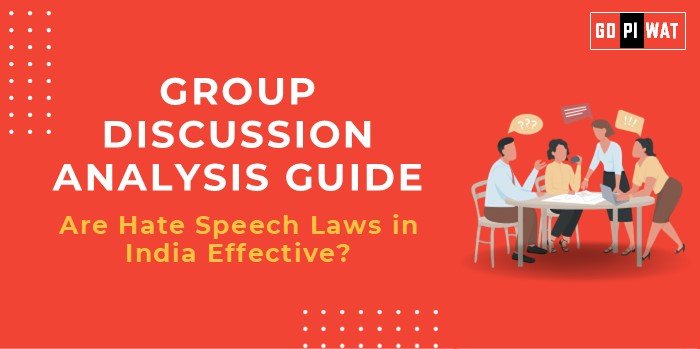📋 Group Discussion (GD) Analysis Guide: Are Hate Speech Laws in India Effective?
🌐 Introduction to Hate Speech Laws in India
- 📜 Opening Context: Hate speech remains a contentious issue worldwide, with significant social, political, and legal implications. For India, a diverse democracy, the regulation of hate speech is crucial to maintaining social harmony and protecting free expression.
- 📖 Topic Background: India’s hate speech laws are primarily derived from the Indian Penal Code (Sections 153A, 295A, and 505) and the Representation of the People Act, 1951. These laws aim to curb acts promoting enmity between groups and offensive speech. However, debates persist regarding their effectiveness and potential misuse.
📊 Quick Facts and Key Statistics
- 📜 Laws Targeting Hate Speech: Sections 153A, 295A, and 505 of the IPC focus on promoting enmity and hurting religious sentiments.
- 📉 Conviction Rate: As of 2023, hate speech-related convictions remain below 20%, highlighting enforcement challenges.
- 📈 Complaints Growth: Hate speech complaints surged by 30% in 2023, reflecting increased reporting and possibly heightened incidents.
- 🌍 Global Comparisons: India ranks lower in free speech indices compared to countries like the US, reflecting a balancing act between regulation and liberty.
👥 Stakeholders and Their Roles
- 🏛️ Government: Enacts and enforces laws to maintain order and prevent misuse.
- ⚖️ Judiciary: Interprets laws, addresses ambiguities, and ensures balance between freedom of speech and societal harmony.
- 🗣️ Citizens: Responsible for exercising speech rights responsibly and reporting violations.
- 📰 Media and Social Media Platforms: Act as content moderators but often face challenges in detecting and removing hate speech effectively.
🏆 Achievements and Challenges
✨ Achievements
- 🤝 Social Harmony: Reduction in communal violence attributed to strict enforcement in sensitive regions.
- ⚖️ Judicial Interventions: Supreme Court rulings, such as in the Tehseen Poonawalla case, have refined enforcement mechanisms.
- 🤖 Technological Advances: AI-driven tools by platforms like Twitter and Meta help flag hate speech automatically.
⚠️ Challenges
- 📉 Selective Enforcement: Allegations of bias in applying laws based on political or religious affiliations.
- ⏳ Judicial Overload: High pendency rates dilute the deterrence effect.
- ⚖️ Freedom of Speech Concerns: Overreach leads to suppression of legitimate dissent.
Global Comparisons:
• United States: Relies on First Amendment protections, making hate speech harder to regulate.
• Germany: Enforces strict hate speech laws under the Network Enforcement Act, ensuring accountability for online platforms.
Case Study: 2018 Kathua Case: Effective legal action showcased the potential of hate speech laws when implemented rigorously.
📢 Structured Arguments for Discussion
- 💬 Supporting Stance: “Hate speech laws are essential for India to maintain communal harmony in a pluralistic society.”
- 🗣️ Opposing Stance: “The current framework often stifles free speech and dissent due to vague definitions and inconsistent enforcement.”
- ⚖️ Balanced Perspective: “While hate speech laws are necessary, reforms are essential to address misuse and ensure they don’t undermine free expression.”
📈 Effective Discussion Approaches
- 💡 Opening Approaches:
- Use a recent case highlighting the misuse or success of hate speech laws.
- Share global benchmarks for regulating hate speech effectively.
- 💡 Counter-Argument Handling:
- Acknowledge concerns around enforcement while emphasizing judicial oversight.
- Offer global comparisons to highlight gaps and opportunities for improvement.
📊 Strategic Analysis: SWOT Framework
Strengths
- 📜 Legal framework in place.
- 📈 Societal awareness growing.
Weaknesses
- 📉 Low conviction rates.
- ⚖️ Potential for misuse.
Opportunities
- 🤖 Leverage AI tools.
- 📊 Increase transparency in enforcement.
Threats
- ⚠️ Rising political polarization.
- 🌍 Global criticism on free speech indices.
🎓 Connecting with B-School Applications
- 💡 Real-World Applications:
- Explore implications for ethical leadership, governance policies, and organizational diversity management.
- 💡 Sample Interview Questions:
- “What reforms would you suggest to make hate speech laws more effective in India?”
- “How can businesses ensure compliance with hate speech regulations in employee communications?”
- 💡 Insights for B-School Students:
- Developing frameworks to balance regulation and freedom, especially in diverse organizational environments.


